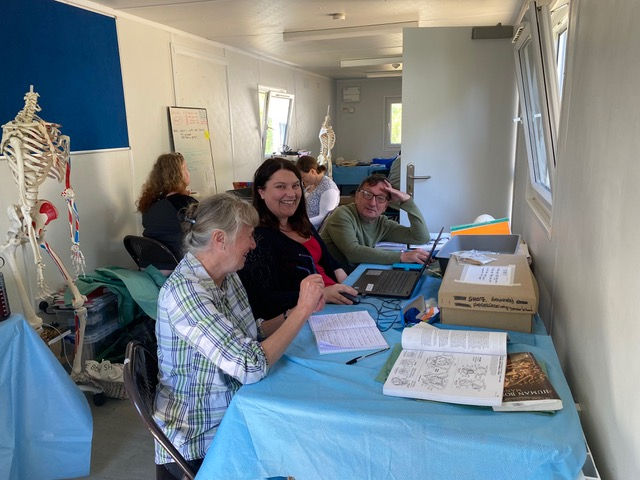Summer Season 2022 - Week Two
- Jul 17, 2022
- 3 min read
Summer Season 2022 - Week Two
Another busy week with very hot conditions saw excavations continuing on all of our excavation trenches.
Chalkpit Field
This week we continued our excavations looking for the N-S ditch on the Eastern side of the malting site, with the BERTs exploring a number of slots across the ditch. This revealed that there may be more than one ditch, perhaps on different elevations. Small investigations of the clay floors for malthouse 1 and 2 started, under the floor of malt house 1 we uncovered a small piece of yellow clay. The floor of malthouse 2 may not have extended as close to the kiln as we previously thought, which may confirm the presence of a wall separating the two.

Drone photo of main excavation trench in Chalkpit Field.

Main excavation trench Chalkpit Field.
Further excavations of kiln 3 revealed that it may be the widest of the three kilns so far excavated. There was more evidence for the destruction of the kiln. The area around kiln 3 and 4 has revealed more daub beyond the clay floor associated with kiln 3, and more debris presumably related to kiln 4.
At the top of the hill, we are continuing to expose more of the area around feature 5. Mass mattocking sessions have reduced the level of the extension.
Saggy Horse Field
By the end of the week the extent of the ditch feature has been revealed (more detail ask phil). In addition to the excavation, a photographic survey by drone was undertaken, with the images then handed over to Peter Stibbons to work his photogrammetry magic... The results of his work can be viewed here https://sketchfab.com/3d-models/sharp-trench-2227-f5ac49e34dde45f28294d7ce0942a63b

Drone photo of Saggy Horse Field evaluation trench, looking south.

Excavating the evaluation trench in Saggy Horse Field.
Chalkpit Quarry
Work began on cleaning the trench opened during set up week. Although initial appearances were not all that positive, careful examination revealed numerous features which we believe relate to the evaluation excavation carried out by the Norfolk Archaeological Unit in 1991 and the subsequent laying of a drainage pipe by Anglian Water.
Human Remains
This week the Human Remains Team has been busy, with a lively gang of volunteers helping to record disarticulated human remains. This is work is part of a National Lottery Heritage Fund project, and we are currently working on the bones excavated in 2000. We were delighted to be able to re-associate some bone fragments with their original skeletons. A young skeleton (S0081) nicknamed "Ceawlin", who had signs of Osgood Schlatter (a common cause of “growing pains” in active teenagers), had some missing toes returned to them. We were able to make this re-association definitively by fitting the ends of bones together – these are unfused in young people so can separate but fit back neatly.

Human Remains volunteers sorting disartic.
Another individual nicknamed “Marty” (S0127) had their legs returned to them. These had been moved by Early Medieval grave diggers and placed within the grave of “Becky” (S0083) who had been buried at a later time.
This year, we are running our human remains short course off-site. This new format has worked well, with lots of HR volunteers able to work with us onsite to gain hands on experience in osteology. We would love to have more people join us in future years to continue this work. If you haven’t already had training or experience with human remains, you could attend our upcoming course in Gloucester in October 2022 - “Introduction to Human Skeletal Remains: Osteoarchaeology Investigations” - just get in touch with Brian, our Bookings manager, on bookings@sharp.org.uk

Human Remains volunteers group photo.
The three Roman vessels excavated from Saggy Horse Field in 2019 have also now been fully micro-excavated. The vessels themselves have been provisionally dated to 1st - 2nd century. The largest contained cremated human remains, as well as an unburnt pig rib. Computed Tomography (CT) scans, obtained before the micro-excavations, will aid reconstruction and assessment of the vessels’ contents in more detail. There is still plenty of work to be done, including full osteological analysis, environmental sampling, organic residue testing, and radiocarbon dating.

Roman urn containing cremated human remains.
The collection phase of the Donated Photo project has also started. We are gathering peoples’ photographs of excavations in Boneyard, to capture as much information about the archaeology as possible. You can read more about this exciting project here https://www.sharp.org.uk/digitaltrenches
Lecture
On Tuesday we were very grateful to David Robertson for a revealing insight into Seahenge and its sister site discovered on Holme beach. He explained about the decisions made during the recovery of seahenge and how the sister wood henge had been recorded as it was lost to the sea. He ended by discussing their construction, the possible meanings and ended with a reconstruction of the site.
Friday Evening
Our Friday evening was filled with music. The early part of the evening we had the fabulous Issy followed by Two Cats and Payne. After the live music we filled the rest of the evening with Karaoke.




































Comments